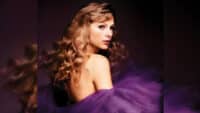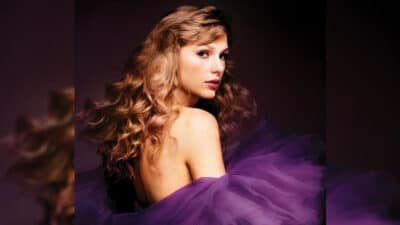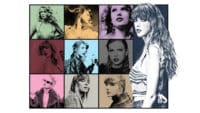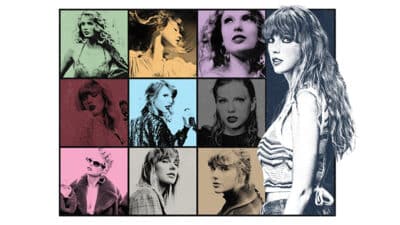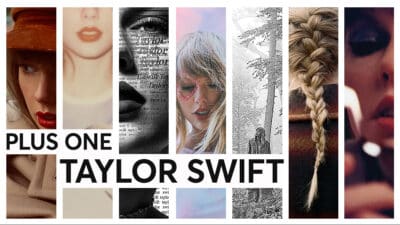Review

Review
1989 (Taylor’s Version): track by track
In celebration of the re-release of 1989, we break down Swift’s fifth (and fourteenth) studio album track by track
When we pressed play on ‘Welcome To New York’ back in 2014 and that clap track kicked in, we all knew we were in for something different. Then came that synth riff. The jaws of country fans everywhere fell open. Stetsons went tumbling to the floor. Taylor Swift had gone pure pop. Lead single ‘Shake It Off’ had technically been our official introduction to her new sound, but its tongue-in-cheek lyrics and acoustic drum line were reminiscent enough of ‘We Are Never Getting Back Together’ that we could be forgiven for thinking we were in for another country pop record. Enter Max Martin.
Swift’s previous album, Red, had been a mosaic portrait of a broken-hearted woman in her early 20s. She cried, she reminisced, she daydreamed, she pleaded, and she eventually accepted. Thematically, the album was cohesive, but many critics commented on its slightly uncertain sonic identity. Country pop lead single ‘We Are Never Getting Back Together’ leaned a little heavier into pop than Swift’s fans were used to, whilst later single and radio hit ‘I Knew You Were Trouble’ employed a dubstep production that didn’t sound like anything we’d heard from the singer before. Red was a record by a country artist chomping at the bit of pop stardom.
On 1989, Swift’s main message is this: she’s a pop star now, and pop stars aren’t sad. Instead of sitting at home nursing broken hearts, pop stars go dancing with their friends. They do the heart breaking, and when one love ends, they jump straight into the arms of the next. And they do all of it in the public eye. Where Swift’s pop-star persona shifts from sincere to satire isn’t always clear, which seems to be how she wants it. A line has been drawn between the diary-esque, intensely confessional lyrics of her first four albums and the stylised songwriting that crops up on 1989. But there is still a wealth of excellent storytelling here, as Swift satirises herself in ‘Blank Space’, weaves a doomed love story in ‘Out Of The Woods’, and heals from heartbreak in ‘Clean.’
The ‘From The Vault’ tracks, often a mixed bag, show that Swift was intentional in every song she placed under consideration for 1989. Sonically, all five would have slotted in perfectly on the original tracklist. Certain aspects of these songs push back against Swift’s squeaky-clean, nice girl 2014 image, which is perhaps why they were shelved. Post-Reputation and now outspoken on the damage that ‘nice’ does, 33-year-old Swift is perfectly placed to release them.
1. ‘Welcome To New York’
It may have nearly put some longtime Swifties into cardiac arrest back in 2014, but that’s exactly what ‘Welcome To New York’ came to do. When we left her in Red, Swift was opening herself up to the possibility of finding love again with soft country guitar ballad ‘Begin Again’. ‘Welcome To New York’ corrects the narrative: actually, she’s moving to New York with all of her friends. Also, guitars are out and synths are in. The opener to 1989 introduces us to an older, more confident, more openly progressive Swift. “And you can want who you want, boys and boys and girls and girls,” she shrugs.
On the new album, ‘Welcome To New York’ is just as bright and overexcited as ever, those synths glossier, Swift’s vocals even more processed, like she’s singing down at us from a billboard. It’s not quite been a decade since Swift first recorded this song, and whilst her vocals have definitely matured, she still sells the wide-eyed newcomer in the big city like she did back in 2014.
2. ‘Blank Space’
Four wistful synth notes, and we’re away. Five albums in, Swift’s public image was established enough that she was ready to start satirising it. Styling herself as an unhinged maneater, she addresses the latest object of her affections and explains to him how it’s all about to go down. “Darling I’m a nightmare dressed like a daydream,” she winks. In the song’s big electropop chorus she tells him that she’s “got a long list of ex-lovers – they’ll tell you I’m insane.” It’s a lyric so famous that a mishearing of it became a popular meme, with Swift herself eventually addressing the fact that, no, she isn’t talking about ‘Starbucks lovers’.
‘Blank Space’ manages to be a tome of a pop song, a huge electropop number that somehow feels more personal manifesto than club banger. The production on the original track is near flawless, from that continued synth riff, eventually almost buried under drums but still persistent, to the quiet pen click at the end of the chorus. New details pop out in the re-record – that buzzy bassline, for one – and Swift’s vocals have a new power that truly sells her character.
3. ‘Style’
Far be it from us to speculate which of Swift’s exes inspired which songs, but she may have dropped some hints in this one. ‘Style’ is a further acknowledgement of the way her public image constantly collides with her personal life – this relationship doesn’t exactly work but goddamn, the aesthetics are good. They’re something out of a movie, as Swift makes clear. “You’ve got that James Dean daydream look in your eye, and I’ve got that red lip classic thing that you like,” she sings. Like much of 1989, ‘Style’ also sounds incredibly cinematic; a hushed intro and conspiratorial pre-chorus that leads into a huge, triumphant wall of sound when the chorus hits. The new ‘Style’ is crisper, the electric guitar getting moments to shine and the chorus twinklier than ever, but otherwise it remains the seductive piece of pop we know and love.
4. ‘Out Of The Woods’
This may not be a breakup album exactly, but would it be a Taylor Swift album without a couple of breakup songs? ‘Out Of The Woods’ is her biggest, poppiest breakup track yet. That distorted, descending vocal riff comes in and out as Swift flexes her storytelling muscles and brings us all the way through this doomed love story from beginning to end. When the chorus hits, she invites us into her anxious mind, constantly asking her if it’s all good yet or if there’s more conflict to come. The whole thing ends in a literal car crash, and Swift decides maybe it’s time to walk out. “But the monsters turned out to be just trees,” she sings. “When the sun came up, you were looking at me.”
That opening descending riff comes in with even more confidence on the re-record, and Swift continues to pull out the small percussive details in the arrangement that may have been lost in the mix the first time around. She doesn’t sound so much like she’s trying to do an impression of her younger self here – this version ‘Out Of The Woods’ feels like a Midnights track, a reflection back on the relationship years on, with Swift turning it into just a good story.
5. ‘All You Had To Do Was Stay’
Swift’s pop iteration loves a marching drum beat, which she employs gleefully in ‘All You Had To Do Was Stay’. The original track sounds so deeply rooted in 2014 pop that it’s hard to envision Swift recording it afresh for 2023 without changing a thing, but we’re glad she doesn’t. In both versions, old and new, the song remains a perfect time capsule. That falsetto ‘stay’ is bolder in the new version and more operatic, but the track is otherwise a pretty perfect copy of the original.
6. ‘Shake It Off’
No matter how you feel about it, there’s no denying that Swift’s big pop breakthrough was a hit. The song dominated radio at the time of its release, and it still isn’t quite finished. Swift’s lyrics were simpler than fans were used to, easy for anyone of any age or language to pick up and sing along to, but the bid for mass appeal didn’t backfire. With ‘Shake It Off’s horns, giggles and cheerleader-inspired middle-eight, Swift proved that she could do just as well in feel-good pop as confessional country. And she even managed to throw in a joke. “You could have been getting down to this sick beat,” shouts Swift, before dropping the world’s tamest beat.
Swift has been meticulous on the new recording. Every giggle, sigh and glottal stop is in place – clearly the singer wants to give the huge amount of clubs and radio stations still hooked on ‘Shake It Off’ no reason not to swap out the old and bring in the new. It’s only on the song’s middle eight chant that she shows her hand. It’s hard to recite those words in your thirties and not inject a little extra self-awareness.
7. ‘I Wish You Would’
The crown for catchiest, poppiest track on Swift’s catchiest, poppiest album is a contested one, but ‘I Wish You Would’ has to rank highly. She’s hopeful and slightly desperate on the song’s verses, waiting for an ex-love to drive back in her direction and ask to give it another shot. But the chorus sends everything spinning, Swift switching up the tempo to yearn after her lover in slow-motion whilst sacrificing none of the track’s momentum. As is true across 1989, there are great riffs here (that repeated “I wish I wish I” in the background of the bridge, for example) but it’s Swift’s ability to combine her country storytelling with pop simplicity that shines. The new recording preserves ‘I Wish You Would’ in all its earworm glory, with Swift’s vocals retaining that same breathless quality.
8. ‘Bad Blood’
The writing of ‘Bad Blood’ feels like it may have been more of an excuse to make the music video than anything else. If you haven’t seen it, Swift packs a mysterious taskforce with every major supermodel and zeitgeisty name of the mid-2010s in order to do battle with Selena Gomez. She also recorded a single version of the track with Kendrick Lamar. 2014 really was a time to be alive.
Swift’s older self hits the vocals hard enough to make the public forget this alleged feud with Katy Perry was ever buried (Perry appeared in Swift’s ‘You Need To Calm Down’ and the two shared a hug whilst dressed as a burger and fries, respectively). If you need evidence of Swift’s vocal evolution, head straight to those ending ad libs.
9. ‘Wildest Dreams’
Those seductive drones draw us straight back into the silver screen. “Say you’ll remember me, standing in a nice dress, staring at the sunset, babe,” sings Swift. From the muted drums to the glossy harmonies, ‘Wildest Dreams’ is truly pop perfection. The original recording also sees Swift deliver one of her best vocal performances, gorgeously breathy across two octaves. The new strength in Swift’s voice means that she no longer sounds like she’s about to float away, but that’s okay – her plea for remembrance comes straight from the chest.
10. ‘How You Get The Girl’
‘How You Get The Girl’ is probably the song on 1989 that feels like it could have easily have found itself on Red. A fun piece of folk-tinged pop, it sees Swift give a hopeless suitor some much-needed advice over an upbeat acoustic guitar riff. Eventually it all gives way to a big electropop chorus, because Max Martin. The original recording really couldn’t be more joyful, which is why there isn’t much for the rerecord to improve on here. Instead, Swift faithfully recreates ‘How You Get The Girl’, right down its youthful vocals.
11. ‘This Love’
“These hands had to let it go free, but this love came back to me,” sings Swift over cautiously humming synths, an echo on her layered harmonies that gives the whole thing a sense of space, like expanding the aspect ratio. The cheerful pop vocals on ‘This Love’ give way to something soft and reverent as Swift breathes a second life into her love story. The new recording is richer, caramelised by a crisper production and Swift’s slightly deeper, smoother vocals.
12. ‘I Know Places’
Swift outruns watching eyes on ‘I Know Places’. Tense, minor verses melt into big major choruses as she and her love make a euphoric break for it. “They are the hunters, we are the foxes, and we run,” she sings. A marching drum beat gives the impression that said hunters are always right on her heels. There’s a noticeable difference between the old and new here – where 2014’s ‘I Know Places’ melted into the rest of the tracklist somewhat, 2023’s version shines thanks to Swift’s performance. From her crisp, whispery ‘s’s to the growl on that opted up “we run”, excellent vocal choices are being made throughout. Where in the original she has a tendency to go breathy, intimidated by those on her tail, in the new recording her voice has a strength to it throughout that suggests that she won’t go down without a fight.
13. ‘Clean’
This was the original 1989 album closer, a cathartic, healing era break-up song that sees Swift finally let go of her heartbreak. Playing both with Biblical flood imagery and the idea of a cured addiction, she’s optimistic, but cautiously so. “Ten months sober, I must admit, just because you’re clean don’t mean you don’t miss it,” she confesses. The thoughtful, quietly triumphant production from Imogen Heap shines on both tracks, with the percussive ‘raindrops’ given more of a starring turn this time around in the song’s chorus.
14. ‘Wonderland’
Swift takes a trip through the looking glass in ‘Wonderland’, reflecting back on a relationship that was wonderful until it wasn’t. She’s still partial to a marching drum here, but ‘Wonderland’s production is altogether a little less sparkly than on the rest of the album, Swift bringing in some buzzy synths to dirty the arrangement. Once again, it’s her vocals that differentiate the new from the old. After almost a decade in pop music, Swift now knows how to stand out against a wall of big pop production rather than melt into it.
15. ‘You Are In Love’
Just as she did on Red with ‘Begin Again’, Swift assures us that she is still in love with love. ‘You Are In Love’ documents the slow, skittish process of realising that you’re falling hard and all the small moments that lead up to it. “And you understand now why they lost their minds and fought the wars, and why I’ve spent my whole life trying to put it into words,” sings Swift wistfully. The production on the new track brings out delicate, distant drum fills and swelling, sparkling synths, whilst Swift’s vocals feel even more vulnerable and full of longing.
16. ‘New Romantics’
Fan favourite ‘New Romantics’ is the bonus track turned single that cheerfully casts Swift and her friends as hedonistic, privileged creatives on a self-destructive mission to get their hearts broken. “The rumors are terrible and cruel, but honey, most of them are true,” shrugs Swift. It’s a sparkly synth-pop gem that satarises a different facet of Swift’s public image, but also lets us know that if the worst things they can say are that she goes out too much and has too many friends, she’ll take it.
It’s fun to hear a now thirty-three-year-old Swift sing about how she and her friends are “so young, but we’re on the road to ruin.” With almost ten years of hindsight, the song’s point – that she will always remember this as a positive phase of her life, no matter the heartbreak and public scrutiny that came with it – feels proven.
17. ‘Slut!’
The first ‘From The Vault’ track, ‘Slut!’ immediately settles easily into the universe of 1989, with its twinkly intro and breathy vocals. Narrative-wise it seems to pick up right where ‘New Romantics’ left off: “Clink, clink, being this young is art,” sings Swift. But in many respects the track is a more vulnerable ‘Blank Space’, a franker look straight into the public eye. “But if I’m all dressed up, they might as well be looking at us,” says Swift. “And if they call me a slut, you know it might be worth it for once.” The production never becomes as full and busy as the title’s exclamation point might suggest – instead, the track is restrained and quietly shimmery, Swift toying with the idea that being what everyone thinks she is might not actually be so bad.
18. ‘Say Don’t Go’
‘Say Don’t Go’ also employs a contained, cautiously mounting kind of electropop in its production, but Jack Antonoff is allowed his big chorus as Swift eventually fails to control her feelings. Trying to play the cool girl doesn’t work, and the chorus brings a barrage of questions for the one that hurt her. “Why’d you have to lead me on? Why’d you have to twist the knife?” she demands. More than anything, she wants to be wanted. Swift gives a passionate vocal performance, but the fact that we’ll never hear ‘Say Don’t Go’ sung by her younger, more vulnerable self is a shame.
19. ‘Now That We Don’t Talk’
A bitter piece of disco pop, ‘Now That We Don’t Talk’ sees Swift making sardonic observations about an ex’s conduct since they split. “I guess I don’t have a say, now that we don’t talk,” she sighs. It stings, but every cloud has a silver lining. In the song’s outro, Swift has the ever-relatable realisation that now it’s all over, “I don’t have to pretend I like acid rock.”
20. ‘Suburban Legends’
Another self-aware step back, in the dreamy, triumphant ‘Suburban Legends’ Swift considers what it means to be half of a ‘power couple’. Her partner is powerful, magnetic and cool, and she feels herself scrabbling to keep up with him and maintain their status as household names. But she can admit that the satisfaction she takes in the relationship is akin to high school dreams of walking in on the arm of the popular boy. In the end, she has to force the relationship down the path everyone expects it to take. “I broke my own heart ‘cause you were too polite to do it,” she sings.
21. ‘Is It Over Now?’
How on earth did ‘Is It Over Now?’ not make the original tracklist? Maybe the allusions to sex were to risqué for Swift’s brand at the time, or maybe the track spoke too damningly about a certain boyband member. “If she’s got blue eyes, I will surmise that you’ll probably date her,” sings Swift. “You dream of my mouth before it called you a lying traitor.” The twinkly synth-pop sonics of it all have never been twinklier, as Swift confesses the darkest things she’s considered doing to get her ex’s attention. What an ace of an unreleased track to have up your sleeve.
Taylor Swift: The Eras Tour is coming to the UK in 2024. Find tickets for Taylor Swift here.




